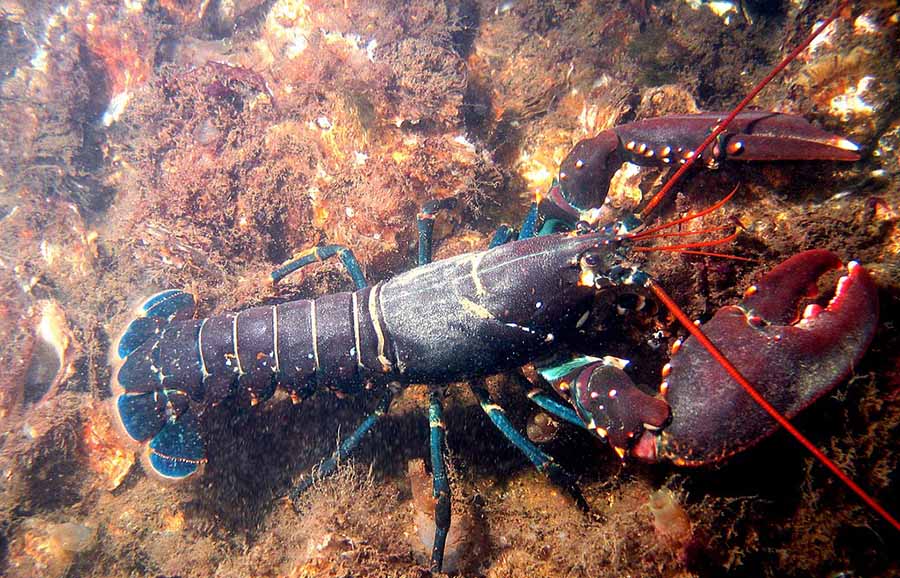They look like something from a bad science fiction film yet taste like something from heaven. Lobsters are fascinating creatures., but how do lobsters communicate?
You may have heard that lobsters have no vocal cords, and you heard right (the noise that some people report hearing when they drop them in boiling water is air being expelled from the stomach). So, with no vocal cords to communicate via noise, how do our delicious crustaceans ‘talk’ to each other?
Let’s find out how lobsters communicate.
Lobster language
We humans might not be very sophisticated with our noise-only communication. But when lobsters wish to communicate, they are much more advanced and pee in each other’s faces. They use urine signals to communicate by injecting chemicals known as pheromones into the urine and squirting it at their surroundings.
When urine is not just urine
Lobster bladders are found in their heads (lobsters have two, one on either side of their heads). They are located directly below their brains, and a lobster urinates from tracts just below their antennae. Special glands called nephropore rosette glands are connected to the urinary tract. These nephropores produce pheromones that can be injected into the urine stream and used to signal intent.
This urine release jet has been measured at up to seven lobster body lengths away. Powerful peeing!
The animal kingdom loves its urine
Of course, lobsters are not the only animals that communicate via urine. Indeed, a lot of animals use pee as a signal, including our best friends, dogs. They use their urine as a way of marking territory. But not many creatures have the audacity to pee in each other’s faces.
Lobster battles
Scientists believe that most of this lobster ‘communication’ is about mating behaviors. Lobsters are solitary animals and quite grumpy. They don’t like mixing with other lobsters. Often, and particularly with males, two lobsters in the same territory ends in fights. They might have a ‘who’s got the biggest claw’ competition first, but if that doesn’t sort it out, they’ll be a few rounds of clawicuffs to establish crustacean dominance.
Read more: Mola Mola Fish: Natural Anomaly and Evolutionary Eyesore
What are they communicating?
The winner receives first dibs on the premium real estate and attracts the first females. But how? It’s not like there is an audience to the lobster equivalent of fight night. And that’s where the pheromones come in. Researchers believe that somehow the winning lobster’s urine smells differently, which is used as a message. It is possibly to do with the level of pheromones and how much serotonin the triumphant lobster produces. These chemical changes ‘smell’ differently to a female, making it more likely they will come to that particular male.
But what about the females?
Don’t the female lobsters get a chance to pee-talk as well? Oh yes, not to be left out; the females use their seductive urine to soothe a potential mate.
If a female approaches a male burrow and likes the smell of his urine, she will cautiously move closer until she can urinate in his face. This sexy move seems to reduce the male’s aggression and signify it’s time to shack up together.
Temporary accommodation
Female lobsters will move in for approximately two weeks, during which time they will mate, and she’ll take the opportunity to shed her shell. A lobster is vulnerable without its protective shell, so the female reduces the risk by doing this while having the additional safety of the male burrow.
But once the two weeks are up, the female will move out, and the male can start peeing for the next lucky lady.
Why would you pee from your face?
A lobster’s primary protection comes from its large front claws. When burrowing, a lobster goes in backward so that its claws are available for defense. If the lobster were to pee from the rear, they would very soon be sitting in a pool of their pee. A bit like that old adage about peeing in a wetsuit to keep warm, the lobster would quickly be pretty smelly.
But more importantly, the all-important pheromone messages would not be distributed towards any oncoming lobster. Our crafty crustaceans solve this tricky issue by urinating from their faces.
Read more: What Is The Black Swallower Fish & Should You Be Scared?
Lobster fun facts
- The American lobster can live for well over 50 years. But other species like the spiny lobster live less than 20 years.
- Adult lobsters can be up to 25 inches (64 cm) long and weigh over 40 lbs (20kg)
- Lobsters come in different colors. Blue, red, yellow, and orange lobsters exist due to genetic mutations that cause imbalances in different proteins. Regular lobsters are a dirty brown. They only turn red when boiled.
- A female can hold on to a male’s sperm for over a year before fertilizing her eggs.
- A female can carry 100,000 eggs at a time.
- Baby lobsters have a hard life: approximately 10% of lobsters make it from egg to adulthood.
- Lobsters might shed and regrow their shells 30 times during their lifetime.
- Lobsters will eat other lobsters.
- There are around 30 different species of lobster.
- A lobster claw can exert up to 100psi of pressure.
Pee: the animal kingdom’s language of love
How do lobsters communicate? Through their pee. It’s the kind of information you didn’t know you needed. And now you know the answer to that burning question; maybe it’s time for some lovely lobster meat. Boiled lobster, melted butter, and something cold in your glass. Mhmmm.
We’ve also shattered the myth that lobsters mate for life. It is, in fact, only two weeks. But for those two lovely weeks, urine is the language (or at least substance) of love.


